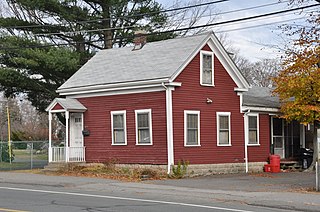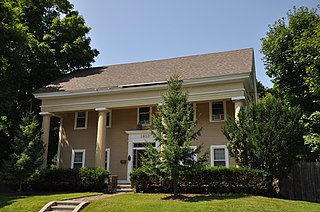
Carlos Avery House is a historic house in the Pittsfield Township, Ohio.
Green's Inheritance is a historic home located at Pomfret, Charles County, Maryland, United States. It is a 2+1⁄2-story gable-roofed house of common bond brick, built about 1850. The house has a basic Georgian plan. It is the only brick house in Charles County dating between the years 1835 and 1880. The house was built by Francis Caleb Green, on part of the 2,400 acres (970 ha) of land granted in 1666 to the sons of Thomas Greene, the second Provincial Governor of Maryland, who named it "Green's Inheritance."

The Caleb Wiley House is a historic house at 125 North Street in Stoneham, Massachusetts. Built c. 1826, this 2+1⁄2-story wood-frame house is one of Stonham's best-preserved late Federal period houses. The house was listed on the National Register of Historic Places in 1984.

The House at 509 North Avenue in Wakefield, Massachusetts is a small Greek Revival cottage. The single story wood-frame house was built c. 1848 and moved to its present location c. 1869. The house is three bays wide and one deep, and exhibits very simple Greek Revival styling, including a boxed cornice and simple door and window surrounds. This house was probably built on land subdivided from holdings of ice companies working on nearby Lake Quannapowitt. Its earliest documented resident was listed in the town's 1869 directory as a shoemaker.

The House at 7 Salem Street in Wakefield, Massachusetts is a transitional Greek Revival/Italianate style house built c. 1855–57. The 2+1⁄2-story wood-frame house has a typical Greek Revival side hall plan, with door and window surrounds that are also typical to that style. However, it also bears clear Italianate styling with the arched window in the gable, and the paired brackets in the eaves. A single-story porch wraps around the front and side, supported by simple square columns. Its occupant in 1857 was a ticket agent for the Boston and Maine Railroad.

The Nathaniel Backus House is a two-story Greek Revival clapboarded house with a gable roof in Norwich, Connecticut. The house was built around 1750 by Nathaniel Backus and served as his home, it was later moved to its current location in 1952. The house originally began as a Colonial, but was greatly modified to Greek Revival around 1825, reconfiguring the central door to the left of the facade and adding two chimneys. The house is a historic house museum operated by the Faith Trumbull Chapter of the Daughters of the American Revolution.

The William D. Roberts House is a historic building located in Provo, Utah, United States. It is listed on the National Register of Historic Places.
The Henry C. Gale House at 495 N. 1st East, Beaver, Utah was built in 1889, of pink rock. It has had three additions since its construction. It is believed to have been built by local Scots stonemason Alexander Boyter. It was listed on the National Register of Historic Places in 1983.

The Howe-Quimby House is a historic house on Sugar Hill Road in Hopkinton, New Hampshire. Built about 1780, it is a well-preserved example of a rural 18th-century farmhouse with later stylistic modifications. The house was listed on the National Register of Historic Places in 1980.

The Durham House is a historic house on Ball Park Road in Goshen, New Hampshire. Built about 1860, it is one of a cluster of plank-frame houses built in the rural community in the 19th century. This one is further note for its Greek Revival features, and its construction is tentatively ascribed to James Chandler, a noted local builder. The house was listed on the National Register of Historic Places in 1985.

The William Rossiter House is a historic house at 11 Mulberry Street in Claremont, New Hampshire. Built in 1813 and enlarged by about 1850, it is a distinctive local example of Greek Revival architecture, with many surviving Federal period features. The house was listed on the National Register of Historic Places in 1979.

Milldean and the Alexander-Davis House, also known as Eaglebrook and the Eagle Hotel, are a pair of historic houses on Main Street in the village center of Grafton, Vermont. Built c. 1826 and c. 1831, the two houses are statewide rare examples of a transitional Federal-Greek Revival style executed in brick. They are also historically significant for their association with Grafton's textile trade, which was economically important in the mid-19th century. The houses were listed on the National Register of Historic Places in 1990.

The Elliot Willden House, at 340 S. Riverside Lane in Beaver, Utah, is a historic stone house built in c.1885, expanding on an older stone cabin. It was listed on the National Register of Historic Places in 1983.
The John Willden House, at 495 N. 200 West in Beaver, Utah, is a historic stone house built in 1875. It was listed on the National Register of Historic Places in 1982.
The Ancil Twitchell House, at 100 S. 200 East in Beaver, Utah was listed on the National Register of Historic Places in 1984.
The William Thompson Jr. House, at 10 W. 400 North in Beaver, Utah, was built around 1880 by Scottish-born local stonemason Thomas Frazer. It was listed on the National Register of Historic Places in 1982.
The Atkins and Smith House, at 390 N. 400 West in Beaver, Utah, was built in 1873.
The John Black House, at 595 N. 100 West in Beaver, Utah, was built around 1910. It was listed on the National Register of Historic Places in 1982.
The Billings-Hougaard House, at 75 E. 300 North, off U.S. Route 89 in Manti, Utah, was built around 1855. It was listed on the National Register of Historic Places in 1980.
The Monk House, in Claiborne Parish, Louisiana near Homer, Louisiana, was built in 1855.












